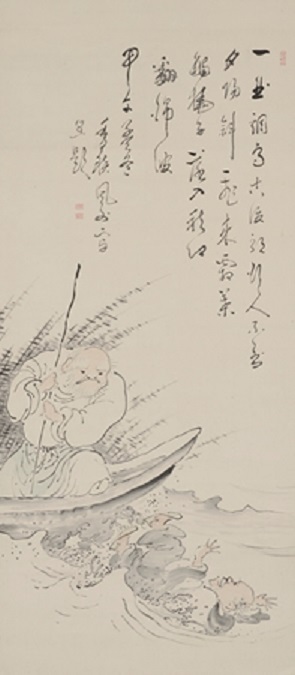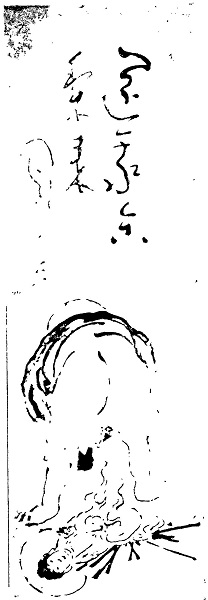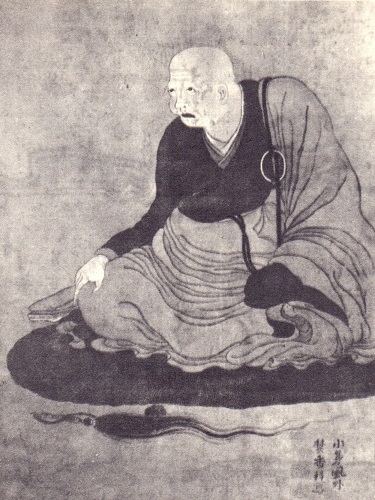ZEN MESTEREK ZEN MASTERS
« Zen főoldal
« vissza a Terebess Online nyitólapjára
風外本高 Fūgai Honkō (1779-1847)

「風外本高像」 横山雲安画
Portrait of Fūgai by 横山雲安 Yokoyama Unan (1814-1880)
名古屋市博物館蔵 Nagoya City Museum
The name "Fūgai" literally means "Outside the Wind," which signifies an existence beyond the cares of everyday life.
He painted in both Zen and Nanga styles and was strongly influenced by the works of
池大雅 Ike no Taiga (1723-1776).
Fūgai Honkō (1779-1847) should not be confused with the famous Sōtō priest and painter Fūgai Ekun 風外慧薰 (1568-1654), especially since Honkō was also a gifted calligrapher. Concerning Honkō, his ordination name should accurately be written Honkō 本光 rather than 本尚,but the second writing of his name has become customary.

「船子夾山図」
Sensu Kassan by 風外本高像 Fūgai Honkō
名古屋市博物館蔵 Nagoya City Museum

Tanka Burning the Buddha
by 風外本高像 Fūgai Honkō
Paintings:
http://www.nagaragawagarou.com/sakuhin/fuugai-e171.html
http://www.nagaragawagarou.com/sakuhin/fuugai-e265.html
http://www.nagaragawagarou.com/sakuhin/fuugai-e227.html

Portrait of 玄楼奥龍 Genrō Ōryū (1720–1813) by Fūgai
龍満寺 Ryūman-ji, Hyōgo Prefecture
鐵笛倒吹
(Rōmaji:) Tetteki tōsui
(English:) The Iron Flute (“Blowing the [Solid-]Iron Flute Upside-Down”)
(Magyar:) Vasfurulya* / Visszáján-fújt vasfuvola**
*©Hetényi Ernő **©Terebess Gábor
This kōan collection had been first compiled in 1783 by Genrō Ōryū, who added his commentary to each kōan in poetry and prose. Later (1788), Genrō's chief disciple, Fūgai Honkō added his own “capping phrases” (jakugo 著語)to the text.
Dharma lineage of Genrō & Fūgai:
永平道元 Eihei Dōgen (1200-1253)
孤雲懐奘 Koun Ejō (1198-1280)
徹通義介 Tettsū Gikai (1219-1309 )
螢山紹瑾 Keizan Jōkin (1268-1325)
峨山韶碩 Gasan Jōseki (1275-1366)
太源宗真 Taigen Sōshin (?-1371)
梅山聞本 Baizan Monpon (?-1417)
恕仲天誾 Jochū Tengin (1365-1437)
喜山性讃 Kisan Shōsan (1377-1442)
茂林芝繁 Morin Shihan (1393-1487)
崇芝性岱 Sūshi Shōtai (1414-1496)
賢仲繁喆 Kenchū Hantetsu (1438-1512)
大樹宗光 Daiju Sōkō
琴峰壽泉 Kimpō Jusen
鐵叟棲鈍 Tetsusō Seidon
舟谷長春 Shūkoku Chōshun
傑山鐵英 Ketsuzan Tetsuei
報資宗恩 Hōshi Sōon
五峰海音 Gohō Kai'on
天桂傳尊 Tenkei Denson (1648-1735)
像山問厚 Shōzan Monkō (?-1776)
二見石了 Niken Sekiryō
玄楼奥龍 Genrō Ōryū (1720–1813)
風外本高 Fūgai Honkō (1779-1847)
ZEN ANECDOTE
in: ZEN: Poems, Prayers, Sermons, Anecdotes, Interviews
Translated by Lucien Stryk & Ikemoto Takashi [池本喬, 1906-1980]
Anchor Books, Doubleday & Co., Inc., Garden City, New York, 1963.
The master Fugai, a fine painter and a successor to Motsugai*, the famous Fist Bonze, was considered very wise and generous, yet he was most severe, both to himself and his disciples. He went to a mountain cave to sit in Zen, and when hungry would come to the village for scraps.
One day a monk called Bundo, attracted by Fugai's austerities, called at the cave and asked the master whether he could spend the night. The master seemed happy to put him up, and next morning prepared rice gruel for him, but not having an extra bowl, he went out and returned with a skull found lying near a tomb. He filled it with gruel and offered it to Bundo. The guest refused to touch it, and stared at Fugai as if he thought him mad. At this Fugai became furious and drove him from the cave with blows. “Fooll!” he shouted after him, “how can you, with your worldly notions of filth and purity, think yourself a Buddhist?”
Some months later the master Tetsugyu** visited him and told him frankly that he thought it a great pity that he had so completely forsaken the world.
Fugai laughed loudly and said, “Oh, it's easy enough to forsake the world and become a bonze. The difficult thing is then to become a true Buddhist.”
It is told that Fugai met his end in an extraordinary manner Feeling his last day had come, he quickly had a hole dug and, standing in it with great dignity, had himself covered with earth.
* 武田物外 Takeda Motsugai/Butsugai, aka 物外不遷 Butsugai Fusen (1795-1867), Soto
** 鐵牛
101 Zen Stories
Transcribed by Nyogen Senzaki ( 千崎如幻 1876–1958) & Paul Reps (1895-1990), Philadelphia, David McKay Company, 1940. 126 p.
is a 1919 compilation of Zen koans including 19th and early 20th century anecdotes compiled by Nyogen Senzaki, and a translation of Shaseki shū, written in the 13th century by Japanese Zen master Mujū ( 無住 ) (literally, "non-dweller"). The book was reprinted by Paul Reps as part of Zen Flesh, Zen Bones.
69. Eating the Blame
Circumstances arose one day which delayed preperation of the dinner of a Soto Zen master, Fukai, and his followers. In haste the cook went to the garden with his curved knife and cut off the tops of green vegetables, chopped them together and made soup, unaware that in his haste he had included a part of a snake in the vegetables.
The followers of Fugai thought they never tasted such good soup. But when the master himself found the snake's head in his bowl, he summoned the cook. "What is this?" he demanded, holding up the head of the snake.
"Oh, thank you, master," replied the cook, taking the morsel and eating it quickly.
![]()
101 zen történet [Kavics és homok]
PDF: 101 zen történet; [ford. Bánfalvi András (1955-2002)]. Farkas Lőrinc Imre Könyvkiadó, [Budapest], 1994, 86 oldal
A zen kapui : százegy zen történet: nincs kapu / [ford. Szigeti György]. Farkas Lőrinc Imre Könyvkiadó, [Budapest], 1998, 147, [6] oldal
PDF: Százegy zen történet 5-97. oldal
Hús-vér zen / összeáll. Paul Reps; [ford. Acsai Roland]. Cephalion Kiadó, Szentendre, 2006, 136 oldal
[E mű négy könyvet foglal magában: A "101 Zen Történetet", mely több mint 500 év tapasztalatából merít, a "Kapu nélküli kaput", mely a megvilágosodást elősegítő, ősi koanok gyűjteménye, A "Tíz bikát", a szellemi előmenetel könyvét és végül a "Középpont felé" című ősi szanszkrit kézirat fordítását.]
69. Lenyelni a szégyent
Fordította: Terebess Gábor (Shaku Genshō)
A Kőrösi Csoma Sándor Intézet Közleményei, 1975. 3-4. szám, 68. oldalVáratlan vendégek érkeztek a kolostorba, és a szerzetes-szakács az összekapkodott zöldséggel, nyisz-nyisz, a nagy sietetségben egy kígyót is beleaprított a levesbe, anélkül, hogy észrevette volna.
Az ebéd közepe táján hívatták és Fúgai* mester egy hang nélkül elétartotta a kígyó fejét. A szakács kiragadta a mester ujjai közül a kígyófejet, egy „köszönömmel" lenyelte, és kisietett a teremből.* Fūgai Honkō (風外本高 1779-1847)
Tarnóczy Zoltán illusztrációja